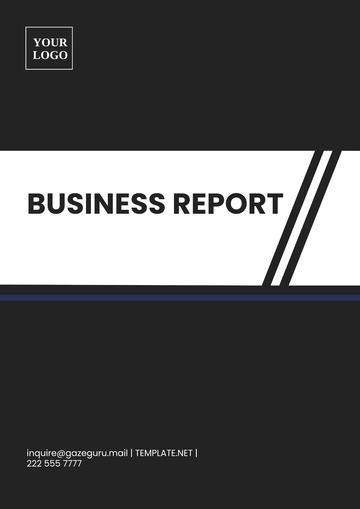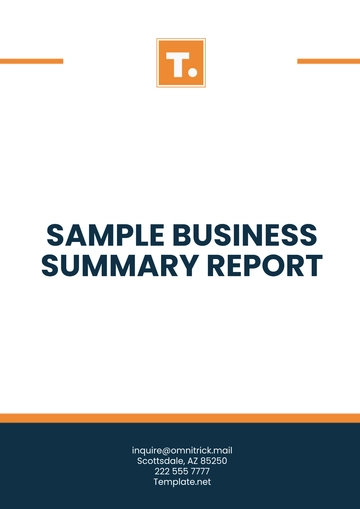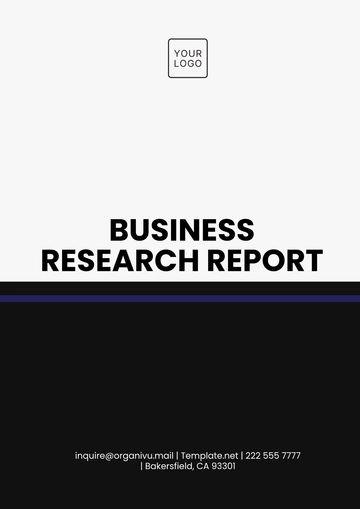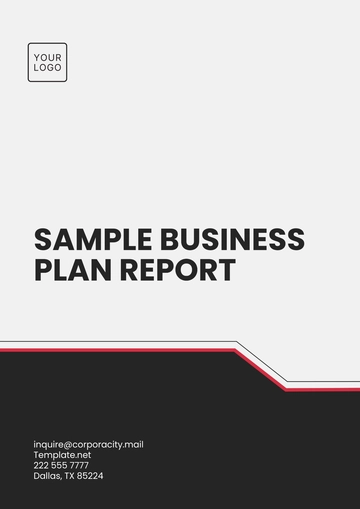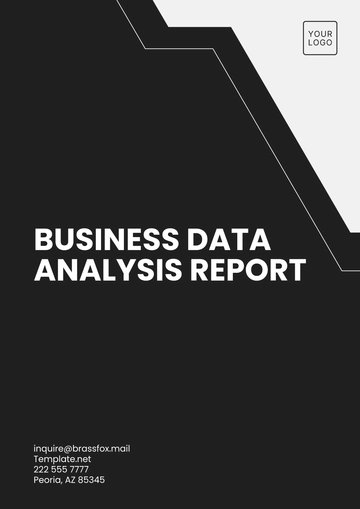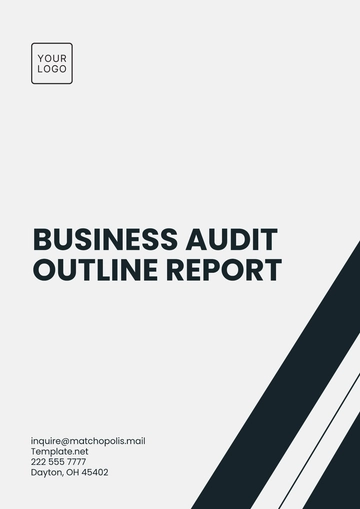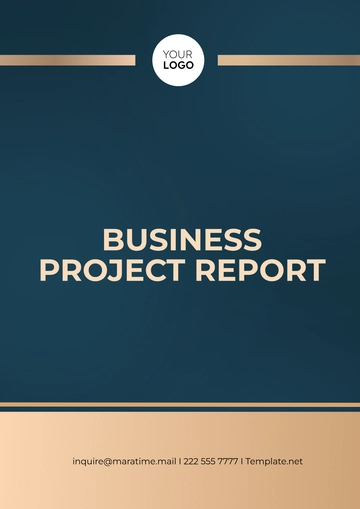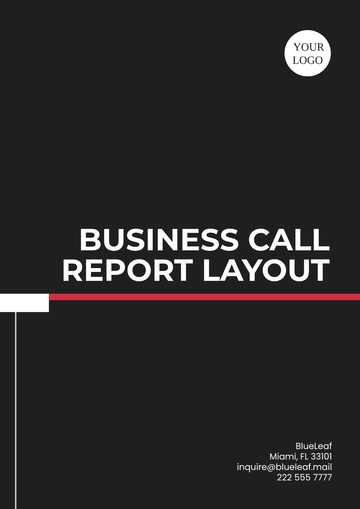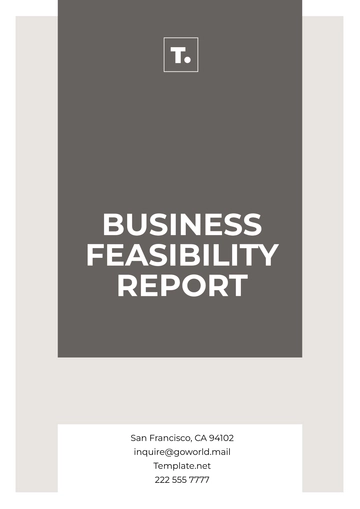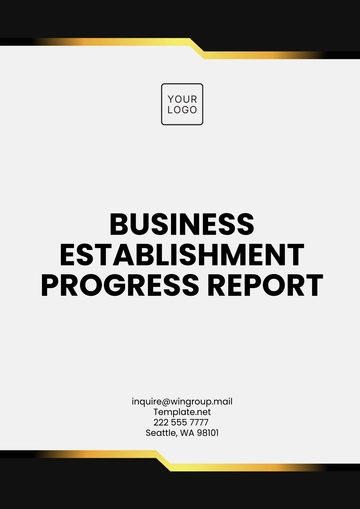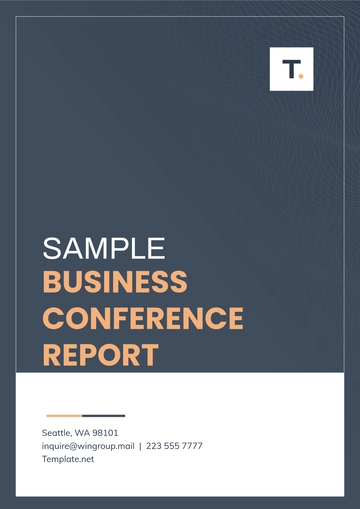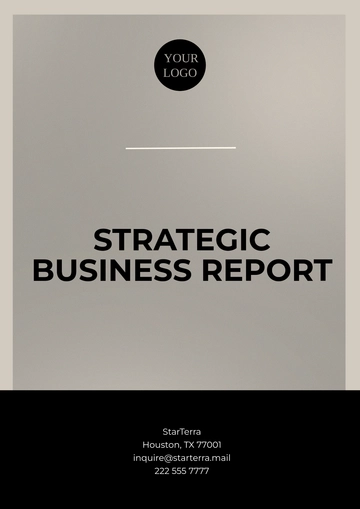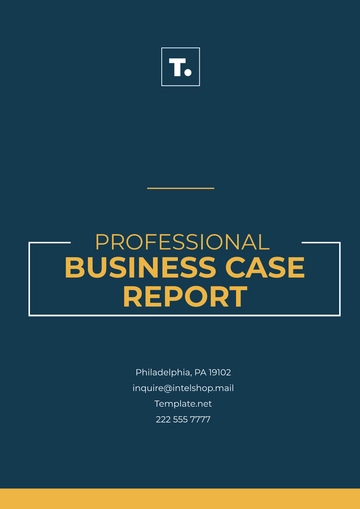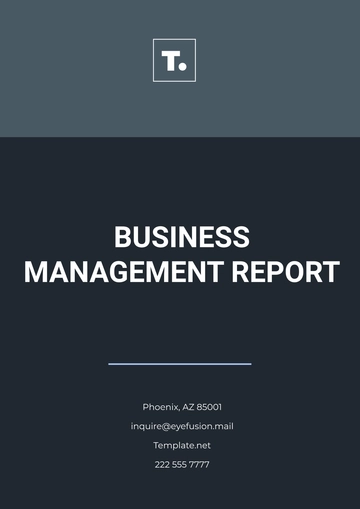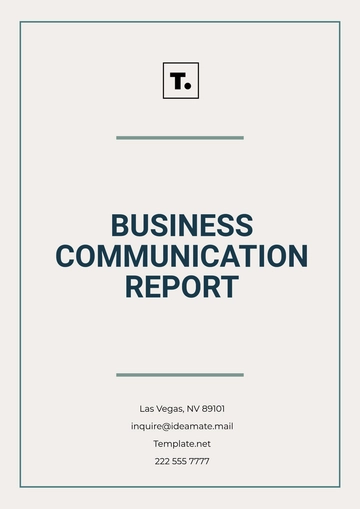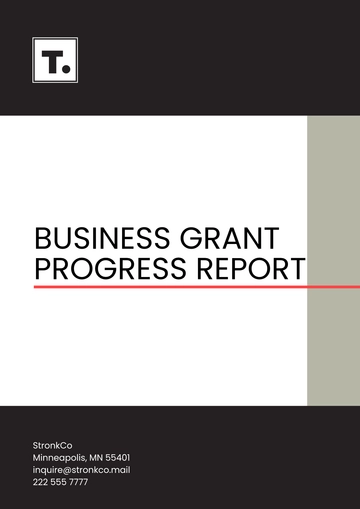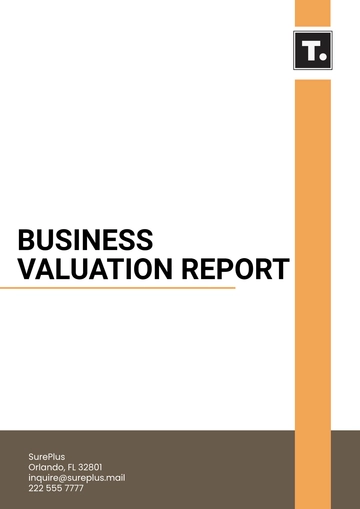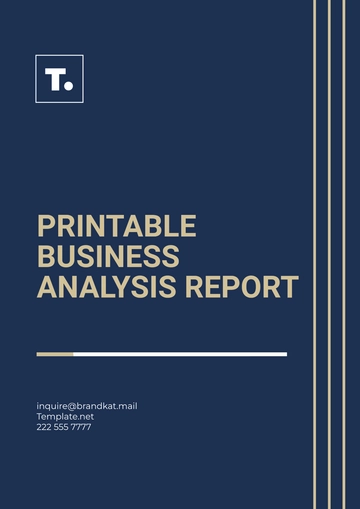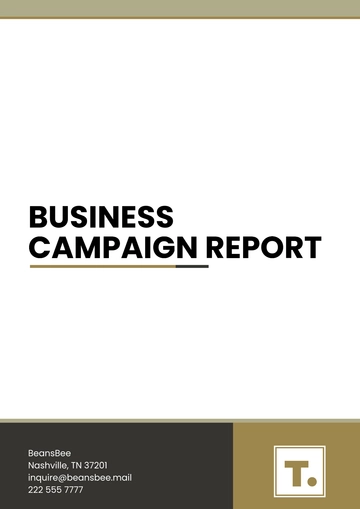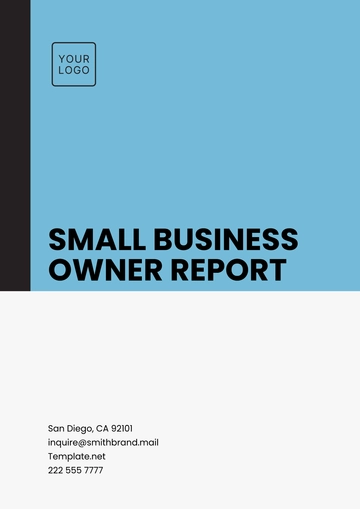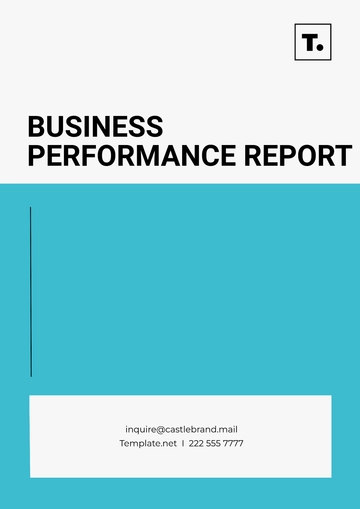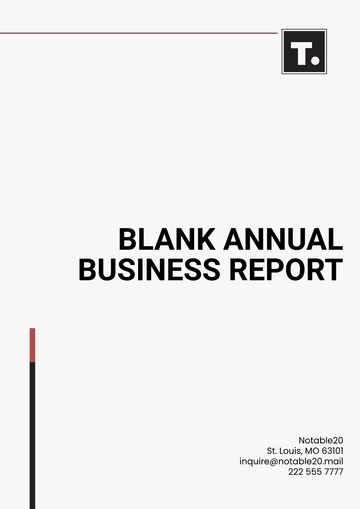Free Cafe Business Report
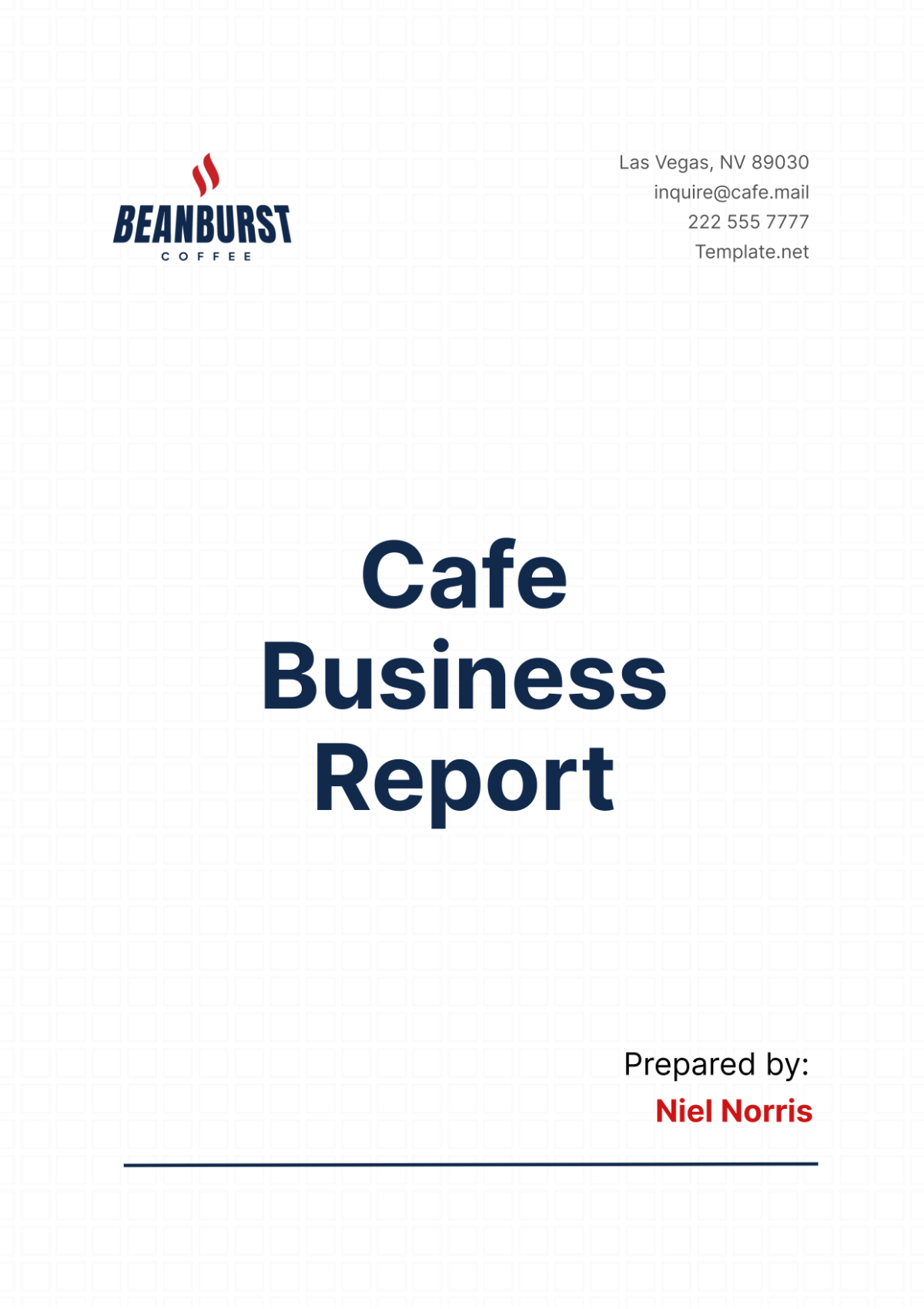
I. Executive Summary
A. Introduction
[Your Company Name] has established itself as a beloved fixture in the community, offering a warm and inviting space where patrons can indulge in premium coffee, delectable food, and engaging conversations. As we navigate the ever-evolving landscape of the coffee industry, it is imperative to assess our current standing, identify areas for improvement, and strategize for future growth. This report serves as a comprehensive analysis of our cafe's performance, outlining key findings, strategic recommendations, and actionable insights to propel [Your Company Name] to new heights of success in the competitive [Tech Industry] sector.
B. Key Findings
Financial Performance: Despite economic fluctuations, our cafe has demonstrated resilience and stability, achieving a commendable 10% year-over-year growth in revenue. However, a deeper examination reveals opportunities for cost optimization and revenue diversification to bolster profitability.
Customer Satisfaction: Central to our success is the unwavering loyalty and satisfaction of our customers, as evidenced by consistently high ratings and positive reviews on various platforms. This serves as a testament to our commitment to quality, service excellence, and community engagement.
Market Trends: In the dynamic landscape of the coffee industry, staying attuned to emerging trends is paramount. We have identified a growing demand for specialty coffee offerings, including single-origin blends and artisanal brews, as well as a shift towards plant-based menu options to cater to diverse dietary preferences.
Operational Efficiency: While our operations run smoothly on the surface, there exist opportunities for streamlining processes, enhancing inventory management systems, and investing in staff training initiatives to improve overall efficiency and productivity.
C. Recommendations
Menu Expansion: In response to evolving consumer preferences, we propose the introduction of innovative menu offerings, including new specialty coffee blends sourced from sustainable and ethically responsible suppliers, as well as a curated selection of plant-based dishes to cater to health-conscious patrons.
Marketing Strategy: To amplify our reach and engagement, we advocate for an integrated marketing approach that leverages digital channels such as social media platforms, email newsletters, and a user-friendly website to showcase our brand story, highlight promotions, and cultivate a vibrant online community.
Operational Improvements: A focus on operational excellence is essential for sustaining long-term growth. We recommend the adoption of advanced inventory management software to optimize stock levels, minimize wastage, and ensure seamless supply chain operations. Additionally, investing in comprehensive staff training programs will empower our team members to deliver exceptional service and uphold our brand promise.
Customer Engagement: Building meaningful relationships with our customers is fundamental to our success. We propose the launch of a customer loyalty program that rewards frequent visits, referrals, and engagement with exclusive perks, discounts, and personalized offers to foster loyalty and incentivize repeat business.
II. Company Overview
A. Company History
Since its inception in 2040, [Your Company Name] has been a beacon of hospitality, bringing people together over a shared love for great coffee and culinary delights. What began as a humble neighborhood cafe has blossomed into a cherished destination beloved by locals and visitors alike. Over the years, we have remained steadfast in our commitment to quality, innovation, and community involvement, earning a reputation as a trusted purveyor of exceptional coffee experiences.
B. Mission and Vision
At the heart of our operations lies a steadfast commitment to our mission: to create memorable moments and foster connections through the art of coffee. Guided by our vision of becoming the premier cafe destination in the region, we endeavor to exceed expectations at every touchpoint, delighting customers with unparalleled service, culinary craftsmanship, and a warm, welcoming ambiance that feels like home.
C. Business Structure
As a sole proprietorship, [Your Company Name] operates under the dedicated leadership of [Your Name], who brings a wealth of experience and passion for hospitality to the helm. Our team comprises a diverse ensemble of talented individuals, including skilled baristas, culinary artisans, and administrative professionals, each contributing their unique talents and expertise to ensure the seamless operation of our establishment.
D. Location and Facilities
Nestled in the heart of [Your Company Address], our cafe beckons with its inviting facade and stylish interior design. Boasting ample seating for up to 50 guests, including a charming outdoor patio, our space is thoughtfully curated to provide a comfortable and convivial setting for patrons to savor their favorite brews and culinary creations. Equipped with state-of-the-art coffee-making equipment and a fully stocked kitchen, we are primed to deliver a memorable dining experience with each visit.
III. Market Analysis
A. Industry Overview
The coffee shop industry continues to thrive, buoyed by a combination of shifting consumer preferences, cultural trends, and evolving lifestyle habits. According to industry reports, the U.S. coffee shop market was valued at an impressive $47.5 billion in 2049, with projected growth fueled by an increasing penchant for premium coffee experiences, artisanal offerings, and experiential dining concepts.
B. Target Market
Our cafe caters to a diverse demographic, with a primary focus on capturing the patronage of young professionals, students, and coffee aficionados aged 18 to 45. In addition to these core segments, we also extend our hospitality to families, tourists, and individuals seeking a welcoming environment to unwind, socialize, or work remotely.
C. Competitive Analysis
In the bustling landscape of the coffee industry, [Your Company Name] faces competition from a myriad of players, ranging from local boutique cafes to national chains. Key competitors include established entities such as Local Cafe A, renowned for its artisanal coffee offerings and community-centric ethos, and National Chain B, which leverages its expansive reach and diverse menu to attract a broad customer base.
D. Market Trends
Specialty Coffee: Discerning consumers are increasingly gravitating towards specialty coffee varieties, drawn to the nuanced flavors, origins, and brewing methods that distinguish each cup.
Health and Wellness: With a growing emphasis on holistic well-being, there is heightened demand for health-conscious menu options, including organic, plant-based, and sustainably sourced offerings that align with dietary preferences and lifestyle choices.
Technology Integration: The integration of technology into the cafe experience continues to evolve, with advancements in mobile ordering, contactless payment systems, and digital loyalty programs enhancing convenience, efficiency, and customer engagement.
IV. Financial Analysis
A. Revenue Streams
Our revenue streams encompass a diverse array of sources, including:
Coffee Sales: Accounting for approximately $300,000 in annual revenue, our coffee offerings represent the cornerstone of our business, attracting connoisseurs and casual drinkers alike with their exceptional quality and variety.
Food Sales: Generating an estimated $200,000 in annual revenue, our food menu features a tantalizing selection of culinary delights, ranging from freshly baked pastries and savory sandwiches to wholesome salads and artisanal desserts.
Merchandise Sales: Contributing approximately $50,000 in annual revenue, our branded merchandise, including mugs, t-shirts, and accessories, serves as both a source of additional income and a means of promoting brand loyalty and affinity.
Event Hosting: With an annual revenue of $30,000, our cafe serves as a versatile venue for hosting a myriad of events, including private parties, community gatherings, and corporate functions, further enhancing our revenue diversification efforts.
B. Expense Breakdown
A comprehensive understanding of our expense breakdown is essential for effective financial management and operational efficiency. The following table provides a detailed overview of our annual expenses:
Expense Category | Annual Cost |
|---|---|
Rent | $60,000 |
Salaries and Wages | $120,000 |
Inventory | $100,000 |
Marketing | $20,000 |
Utilities | $15,000 |
Miscellaneous | $10,000 |
Total Expenses | $325,000 |
Rent: Accounting for a significant portion of our expenses, our monthly rent expenditure reflects the prime location and desirable amenities offered by our cafe's premises. Negotiating favorable lease terms and exploring potential rent concessions can help mitigate this cost.
Salaries and Wages: Our commitment to fair wages and employee satisfaction is reflected in our investment in competitive salaries and benefits for our dedicated team members. Staffing levels are optimized to ensure adequate coverage during peak hours while controlling labor costs.
Inventory: The procurement of high-quality ingredients and supplies is essential for maintaining the integrity and consistency of our menu offerings. Implementing rigorous inventory management practices, including regular stock checks, supplier negotiations, and waste reduction initiatives, can help optimize inventory costs.
Marketing: Investing in targeted marketing initiatives is critical for raising brand awareness, attracting new customers, and fostering customer loyalty. Allocating resources towards digital marketing campaigns, social media advertising, and local promotions can yield a favorable return on investment.
Utilities: Utility expenses, including electricity, water, and gas, are necessary for the operation of our cafe. Exploring energy-efficient technologies, implementing conservation measures, and conducting regular audits can help mitigate utility costs over time.
Miscellaneous: Miscellaneous expenses encompass various operational and administrative costs, including equipment maintenance, licensing fees, and insurance premiums. Monitoring and managing these expenses diligently can prevent overspending and ensure financial stability.
C. Profit and Loss Statement
A detailed analysis of our profit and loss statement provides valuable insights into our financial performance:
Item | Amount |
|---|---|
Total Revenue | $580,000 |
Total Expenses | $325,000 |
Net Profit | $255,000 |
Total Revenue: Our total revenue for the fiscal year stands at $580,000, reflecting the cumulative earnings generated from coffee sales, food sales, merchandise sales, and event hosting services.
Total Expenses: Total expenses amount to $325,000, encompassing rent, salaries and wages, inventory, marketing, utilities, and miscellaneous operational costs.
Net Profit: With total expenses deducted from total revenue, our net profit for the fiscal year amounts to $255,000, underscoring our cafe's profitability and financial viability.
D. Cash Flow Analysis
Maintaining positive cash flow is imperative for sustaining day-to-day operations, supporting growth initiatives, and weathering unforeseen challenges. Our cash flow analysis reveals:
Consistent Inflows: Our cafe experiences steady cash inflows throughout the year, with peak periods coinciding with seasonal fluctuations, holidays, and special events that drive increased customer traffic and sales.
Timely Outflows: To ensure operational continuity and financial stability, we adhere to a disciplined approach to cash outflows, prioritizing essential expenditures such as rent, utilities, inventory replenishment, and payroll obligations.
Working Capital Management: Efforts to optimize working capital include efficient inventory management practices, proactive invoicing and collections, and judicious expense management to maintain adequate liquidity and mitigate cash flow constraints.
E. Financial Projections
Looking ahead, our financial projections provide a roadmap for future growth and performance:
Year | Projected Revenue | Projected Expenses | Projected Profit |
|---|---|---|---|
2050 | $638,000 | $350,000 | $288,000 |
2051 | $700,000 | $370,000 | $330,000 |
2052 | $770,000 | $390,000 | $380,000 |
Revenue Growth: With strategic initiatives in place to drive sales and expand our customer base, we anticipate a steady increase in projected revenue over the next three years, reaching $770,000 by 2052.
Expense Management: While expenses are projected to rise in tandem with revenue growth, our commitment to operational efficiency and cost optimization aims to mitigate the impact on profitability, resulting in healthy projected profits exceeding $300,000 annually by 2052.
Investment Opportunities: As we pursue growth opportunities and invest in our cafe's future, prudent financial management will be paramount to ensure sustainable growth, preserve profitability, and maximize shareholder value.
V. Marketing Strategy
A. Branding and Positioning
Building a strong brand identity is essential for establishing differentiation, fostering customer loyalty, and driving competitive advantage. Our branding strategy emphasizes authenticity, quality, and community, resonating with our target audience and evoking a sense of belonging and camaraderie.
B. Digital Marketing
In today's digital age, a robust online presence is crucial for engaging customers, amplifying brand awareness, and driving traffic to our cafe. Our digital marketing strategy encompasses:
Website Optimization: A user-friendly website serves as the digital storefront for our cafe, providing visitors with essential information, menus, promotions, and online ordering capabilities.
Social Media Engagement: Active participation on popular social media platforms, including Instagram, Facebook, and Twitter, facilitates direct communication with customers, showcases our brand personality, and fosters meaningful connections.
Email Campaigns: Targeted email newsletters deliver timely updates, exclusive offers, and personalized content to our subscriber base, nurturing relationships and driving customer engagement and retention.
C. Traditional Marketing
While digital channels offer unparalleled reach and scalability, traditional marketing tactics remain relevant for reaching local audiences and fostering community connections. Our traditional marketing efforts include:
Local Advertising: Strategic placement of print advertisements in local publications, newspapers, and magazines helps raise awareness and attract foot traffic from nearby residents and businesses.
Community Involvement: Active participation in community events, sponsorships, and partnerships with local organizations and charities strengthens our ties to the community, enhances brand visibility, and fosters goodwill.
Offline Collateral: Eye-catching flyers, posters, and signage strategically placed in high-traffic areas serve as effective touchpoints for capturing the attention of passersby and generating interest in our cafe offerings.
D. Customer Loyalty Programs
Recognizing and rewarding customer loyalty is instrumental in fostering long-term relationships and driving repeat business. Our customer loyalty program aims to:
Incentivize Engagement: By offering enticing rewards, discounts, and exclusive perks, we incentivize customers to frequent our cafe, refer friends, and engage with our brand across various touchpoints.
Personalize Experiences: Leveraging data analytics and customer insights, we tailor personalized offers and recommendations based on individual preferences, purchase history, and behavior, enhancing the relevance and effectiveness of our loyalty program.
Encourage Advocacy: Empowering satisfied customers to become brand advocates, our loyalty program encourages social sharing, reviews, and referrals, amplifying our reach and influence within the community.
VI. Operations Plan
A. Daily Operations
Efficient daily operations are essential for delivering a seamless and exceptional customer experience. Our operational plan encompasses the following initiatives:
Opening and Closing Procedures: Standardized checklists and protocols ensure consistency and efficiency in opening and closing routines, from setting up equipment and prepping ingredients to cleaning and securing the premises.
Inventory Management: Leveraging advanced inventory management software, we implement automated tracking, forecasting, and replenishment processes to optimize stock levels, minimize waste, and prevent stockouts.
Customer Service Excellence: Ongoing staff training programs equip our team members with the skills, knowledge, and mindset needed to deliver attentive, personalized service, anticipate customer needs, and resolve issues promptly and courteously.
B. Staff Management
Our human resources strategy focuses on attracting, retaining, and developing top talent to drive operational excellence and customer satisfaction:
Recruitment and Hiring: Rigorous recruitment processes identify candidates who embody our core values, possess relevant skills and experience, and demonstrate a passion for hospitality and customer service.
Training and Development: Comprehensive onboarding programs and ongoing training initiatives equip our team members with the technical skills, product knowledge, and soft skills needed to excel in their roles and deliver memorable guest experiences.
Scheduling Optimization: Data-driven scheduling tools and methodologies help optimize staffing levels, minimize labor costs, and ensure adequate coverage during peak periods and special events while balancing employee preferences and availability.
C. Quality Control
Maintaining consistently high standards of quality and safety is paramount to earning and retaining customer trust and loyalty:
Product Quality Assurance: Regular quality control checks, taste tests, and sensory evaluations ensure the freshness, flavor, and integrity of our coffee, food, and beverage offerings, meeting or exceeding customer expectations with each serving.
Health and Safety Compliance: Adherence to stringent health and safety protocols, including food safety regulations, sanitation standards, and workplace safety guidelines, is non-negotiable, safeguarding the well-being of both customers and employees.
Continuous Improvement: A culture of continuous improvement and innovation encourages feedback, fosters learning, and drives operational efficiencies and service enhancements across all aspects of our cafe operations.
VII. Financial Plan
A. Capital Requirements
To support our growth initiatives and strategic objectives, we have identified the following capital requirements:
Equipment Upgrades: Investment in state-of-the-art coffee-making equipment, kitchen appliances, and POS systems to enhance operational efficiency, product quality, and customer service.
Marketing Campaigns: Allocation of funds towards targeted marketing campaigns, promotions, and branding initiatives to raise awareness, attract new customers, and drive sales.
Staff Training: Resources earmarked for staff training and development programs, including certifications, workshops, and seminars, to equip our team members with the skills and knowledge needed to excel in their roles and deliver exceptional guest experiences.
B. Funding Sources
Potential sources of funding to meet our capital requirements include:
Bank Loans: Securing a term loan or line of credit from financial institutions with favorable terms and competitive interest rates to finance capital expenditures and working capital needs.
Private Investors: Seeking investment from private investors, venture capitalists, or angel investors interested in supporting our growth trajectory and sharing in our success.
Government Grants: Exploring eligibility for government grants, incentives, or subsidies available to small businesses, startups, or enterprises operating in specific industries or geographic regions.
C. Financial Goals
Aligned with our strategic priorities and vision for growth, our financial goals include:
Revenue Growth: Targeting a double-digit annual increase in revenue through organic growth, menu innovation, and market expansion initiatives.
Profitability: Maintaining a healthy profit margin and achieving sustainable profitability to reinvest in our business, reward shareholders, and fuel future growth.
Financial Stability: Building and maintaining robust cash reserves, liquidity buffers, and contingency funds to weather economic downturns, unforeseen challenges, and market volatility.
Return on Investment: Maximizing return on investment for capital expenditures, marketing initiatives, and strategic projects through diligent financial planning, performance monitoring, and risk management.
D. Break-Even Analysis
A break-even analysis provides valuable insights into our cost structure, pricing strategy, and financial viability:
Break-Even Point: Based on current revenue and expense projections, our break-even point is estimated at $270,000 in annual revenue, beyond which our cafe begins to generate profits.
Sensitivity Analysis: Sensitivity analysis allows us to assess the impact of changes in key variables, such as sales volume, pricing, and costs, on our break-even point and overall financial performance, enabling informed decision-making and risk mitigation strategies.
VIII. Risk Management
A. Risk Identification
Effective risk management begins with identifying and understanding potential risks and vulnerabilities:
Market Risk: Fluctuations in consumer preferences, economic conditions, and competitive dynamics pose risks to revenue growth and market share.
Operational Risk: Equipment failures, supply chain disruptions, staffing shortages, and operational inefficiencies can impact service delivery, customer satisfaction, and profitability.
Financial Risk: Cash flow constraints, liquidity challenges, and unexpected expenses may strain financial resources and jeopardize business continuity and growth prospects.
B. Risk Mitigation Strategies
Proactive risk mitigation strategies help mitigate the impact of identified risks and safeguard our business interests:
Diversification: Diversifying revenue streams, product offerings, and customer segments reduces reliance on any single source of income and enhances resilience to market fluctuations and competitive pressures.
Contingency Planning: Developing contingency plans, business continuity protocols, and emergency response procedures prepares us to respond effectively to unforeseen events, minimize disruptions, and protect assets and operations.
Insurance Coverage: Securing comprehensive insurance coverage, including property, liability, and business interruption insurance, provides financial protection against various risks and liabilities, mitigating potential losses and liabilities.
IX. Conclusion
This comprehensive Cafe Business Report outlines our strategic roadmap for achieving sustainable growth, operational excellence, and customer-centricity in the dynamic landscape of the coffee industry. By leveraging our strengths, addressing areas for improvement, and embracing opportunities for innovation, [Your Company Name] is poised to solidify its position as a premier cafe destination, beloved by patrons for its quality, authenticity, and community spirit.
- 100% Customizable, free editor
- Access 1 Million+ Templates, photo’s & graphics
- Download or share as a template
- Click and replace photos, graphics, text, backgrounds
- Resize, crop, AI write & more
- Access advanced editor
Track and analyze cafe performance with the Cafe Business Report Template from Template.net. This editable and customizable document provides a comprehensive overview of key metrics, trends, and insights relevant to your cafe operations. Crafted for clarity and decision-making, it's editable in our AI Editor Tool, enabling you to identify areas for improvement and optimize cafe performance.
You may also like
- Sales Report
- Daily Report
- Project Report
- Business Report
- Weekly Report
- Incident Report
- Annual Report
- Report Layout
- Report Design
- Progress Report
- Marketing Report
- Company Report
- Monthly Report
- Audit Report
- Status Report
- School Report
- Reports Hr
- Management Report
- Project Status Report
- Handover Report
- Health And Safety Report
- Restaurant Report
- Construction Report
- Research Report
- Evaluation Report
- Investigation Report
- Employee Report
- Advertising Report
- Weekly Status Report
- Project Management Report
- Finance Report
- Service Report
- Technical Report
- Meeting Report
- Quarterly Report
- Inspection Report
- Medical Report
- Test Report
- Summary Report
- Inventory Report
- Valuation Report
- Operations Report
- Payroll Report
- Training Report
- Job Report
- Case Report
- Performance Report
- Board Report
- Internal Audit Report
- Student Report
- Monthly Management Report
- Small Business Report
- Accident Report
- Call Center Report
- Activity Report
- IT and Software Report
- Internship Report
- Visit Report
- Product Report
- Book Report
- Property Report
- Recruitment Report
- University Report
- Event Report
- SEO Report
- Conference Report
- Narrative Report
- Nursing Home Report
- Preschool Report
- Call Report
- Customer Report
- Employee Incident Report
- Accomplishment Report
- Social Media Report
- Work From Home Report
- Security Report
- Damage Report
- Quality Report
- Internal Report
- Nurse Report
- Real Estate Report
- Hotel Report
- Equipment Report
- Credit Report
- Field Report
- Non Profit Report
- Maintenance Report
- News Report
- Survey Report
- Executive Report
- Law Firm Report
- Advertising Agency Report
- Interior Design Report
- Travel Agency Report
- Stock Report
- Salon Report
- Bug Report
- Workplace Report
- Action Report
- Investor Report
- Cleaning Services Report
- Consulting Report
- Freelancer Report
- Site Visit Report
- Trip Report
- Classroom Observation Report
- Vehicle Report
- Final Report
- Software Report
